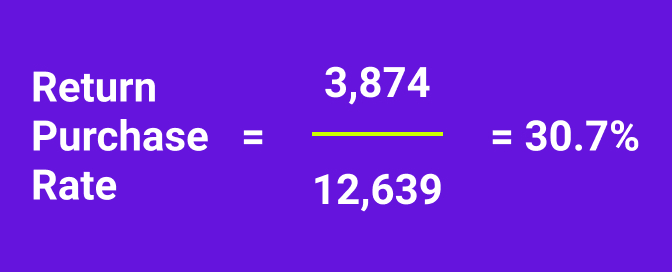
Repeat Purchase Rate: The Secret To Retain Customers
Is there anything better than that feeling you get when a customer makes a purchase from your online store?
You put so much time, energy, and money into making that moment happen – what could possibly top that?
The answer: getting repeat customers and repeat purchases!
Now that is something to get excited about. But what’s the secret to retaining customers and growing your repeat purchase rate?
We’ll cover everything you need to know about repeat purchase rate below, including how to calculate repeat purchase rate, what you can do to keep customers coming back, and more.
Keep reading for all the answers!
What is customer repeat purchase?
A customer repeat purchase is counted as any occurrence of a customer buying products from your business more than one time.
The repeat purchase rate, then, is a metric that calculates how many customers have made more than one purchase from your online store – typically as a percent value.
If your goal is to grow a successful business (we sure hope that’s the case!), it is absolutely critical that you have a clear understanding of what your business’s repeat purchase rate is and how to retain customers in higher numbers.
Curious why? Here are some of the top reasons why you should work on developing repeat customers and repeat purchases:
- The top quartile of companies earn more than 20% of their revenue from repeat customers within the first month after an initial purchase
- After 3 years, the percent of revenue coming from repeat customers grows to 60%
- Increasing customer retention by 5% can result in 25-95% growth in profits
Did you know that you can grow your #ecommercebusiness profits by 25-95% with just a 5% increase in customer retention? Keep customers and raise your bottom line! Click To Tweet
But coming up with effective ways to retain customers can be easier said than done. On average, 63% of customers will not return to make a second purchase. That means roughly 37% of customers will return for a second purchase.
Those might sound like some pretty tough odds to beat, but if you’re able to secure that second purchase, the likelihood of a customer returning for a third purchase actually grows to more than 50%. And the more repeat purchases a customer makes, the higher the odds are that they’ll continue coming back for more.
How can repeat purchase help improve profits?
By working on improving your repeat purchase rate, you’ll also be working on increasing your e-commerce business profits. It’s not an either-or question, far from it! If you’re able to grow your repeat purchase and repeat customer rates, the profits will follow. Here’s how…
First and foremost, more purchases means more revenue, which can ultimately lead to more profits (if you handle your e-commerce expenses correctly, that is). That’s the easiest and most direct way of drawing a line between higher repeat purchase rates and bigger profit margins.
Apart from that, developing repeat customers also means you can reduce the amount of money you put towards e-commerce marketing. Naturally, if you’re able to build up your customer retention, you’ll have less of a need to run online advertisements to bring in new customers, which can take a heavy toll on your business’s profitability. Less advertising means reduced costs and increased profit margins.

Lastly, we shouldn’t forget to mention that word-of-mouth advertising is still known to be the best form of marketing. According to a Nielsen study, 92% of shoppers say they trust word-of-mouth recommendations over all other forms of marketing. Pair that with the fact that repeat customers make more referrals as time goes on, and it becomes clear that increasing your repeat purchase rate can improve your business’s profits.
These processes we’ve just mentioned sound very nice in theory, but how can you really tell if your profit margins are benefiting from your efforts to increase your repeat purchase rates? Well, if you’re running your online business on Shopify, boy have we got a treat for you.
BeProfit – Profit Tracker is the best Shopify app for calculating profit margins and keeping track of expenses. When we say tracking expenses, we mean all of your expenses. We’re talking shipping costs, production expenses, marketing, and anything else you’re paying for while running your Shopify business.
The BeProfit app takes those mountains of data pumped out by your Shopify store and turns them into charts and graphs that make everything easy to understand. And, of course, you can use BeProfit to keep accurate records of how your business progresses over time both in terms of reducing costs and increasing profits. You can even customize and export reports that show the metrics you care about most, finally giving you full control over your Shopify store’s data.
How to calculate repeat purchase rate?
The formula to calculate repeat purchase rate is fairly simple:

It’s important to note that when you run the equation above, you should make sure that you use values from within the same timeframe. For example, if the # of Repeat Customers is from the past month, then the # of Total Customers should also be from the past month.
Let’s use an example to explain with real numbers to demonstrate.
Let’s say there is an e-commerce business owner named Jan who wants to measure her repeat purchase rate for the past year. First, she looks back over her business records for the past year and calculates the two values she needs to run the equation, # of Repeat Customers and # of Total Customers.
Here’s what Jan calculates:
- # of Repeat Customers (last year) = 3,874
- # of Total Customers (last year) = 12,639
With those values in hand, Jan then runs the equation to find her business’s repeat purchase rate for the past year.

Jan is pleased to find that her business’s repeat purchase rate is nearly 31%. She’s been in business for more than 2 years, so she’s happy to see these results, but is still feeling the drive to retain more customers and get them to repeat purchase products more often.
If you’re like Jan and you want to see your return purchase rate grow bigger, take a look at the list below!
Strategies to increase customer repeat purchase rate
- Solve issues that lead to cart abandonment
- Adopt a subscription-based model
- Start a loyalty or rewards program
- Communicate effectively throughout the fulfillment process
- Send a ‘thank you’ email after the initial purchase
- Use smart incentives to get the second sale
1. Solve issues that lead to cart abandonment
One of the best ways to retain customers is to not let them go in the first place. It’s no secret that online shopping cart abandonment is a huge problem for e-commerce business owners. In fact, in March 2020, 90% of online shopping orders around the world were abandoned, demonstrating just how serious of a problem this really is for online businesses.
Address the following roots of cart abandonment and watch as you start seeing more repeat purchases come into your e-commerce store:
- Expensive shipping fees
- Faulty discount codes
- Long delivery times
- Complicated checkout processes
- Limited payment options
- Surprise fees at checkout
2. Adopt a subscription-based model
Another effective strategy that can help you improve your repeat purchase rate is to have your customers sign up for a subscription service offered by your store.
Instead of hoping that the customer will eventually come back to your store on their own accord, you can incentivize them to do so by giving them discounted rates on your products if they subscribe for a monthly delivery, for example.
Granted, a subscription-based business model won’t be an option for every online store. But if you’re creative enough, you can come up with great ways to spark that interest in your customers.
Here are a few types of e-commerce businesses that can make the most out of a subscription-based model:
- Cosmetics
- Baby items
- Toiletries (razors, soaps, feminine products, etc.)
- Vitamins/supplements
- Pet supplies

You can create a subscription-based model with basically any type of product that customers could potentially need to re-stock on a regular basis. Do you think that this idea is nice on paper but not so practical? Think again.
One study found that 15% of all online shoppers have subscribed to an e-commerce service within the past 12 months. If that trend continues each year, there should be no questions about how valuable a subscription option could be for helping your online business get more repeat customers.
3. Start a loyalty or rewards program
If a subscription-based model doesn’t fit the sort of products you’re selling (or even if it does), you should definitely be offering a loyalty or rewards program as a strategy for retaining customers.
Simply put, customers want to feel special. In fact, roughly half of all consumers say they expect special treatment as a reward for being a “good customer”. What does more to make a customer feel special than giving them a status above all other customers?
Try these tactics to help you retain customers and see more repeat purchase products:
- Grant loyal customers VIP access to the best discounts you can offer
- Provide loyal customers with unique opportunities to get premium products that wouldn’t be available otherwise
- Create a points program wherein customers accumulate points each time they make a purchase, which they can then exchange for special discounts
These are just a few examples of loyalty programs. However you go about it, just know that the rewards you get in return can be significant. According to a survey on customer loyalty, 81% of respondents said they’d be more likely to continue doing business with a brand that offers a loyalty program. Don’t miss out on this opportunity to improve your repeat purchase rate!
4. Communicate effectively throughout the fulfillment process
Nobody likes to be left wondering what’s going on with an order they’ve completed online. Putting your trust in a website to hand over your hard-earned money can be a bit unnerving, to say the least. Even if the fulfillment process runs smoothly and there are no complaints, the customer’s experience of sitting and waiting for their delivery without any updates could make them less likely to make a repeat purchase. In fact, roughly 90% of consumers say they started spending money at a competitor after having a bad customer experience with the previous company.
Don’t make the mistake of putting your customers through a frustrating or stressful experience. For you, the most important part of the process is over when you get the payment. For the customer, that’s just the start of the line.
If you want to see more first-time customers turn into repeat customers, be sure to communicate with them as their delivery process progresses so that they have a clear understanding of where it is and how much longer they should expect to wait. Even if it takes the same amount of time either way, if they can keep an eye on the process, it will make them feel more comfortable.

5. Send a ‘thank you’ email after the initial purchase
Here’s one of the easiest ways you can get more repeat purchase products: say thank you! We don’t mean to sound like a nagging grandmother, but seriously – show some appreciation folks! You work so hard to get those sales, it couldn’t hurt to let your customers know how thankful you are for their patronage.
On the one hand, it contributes to the feeling of having a personal experience – something that nearly half of all consumers say contributes to providing excellent customer care.
On the other hand, it gives you an opportunity to invite that customer back for a repeat purchase. You can even mix in a special discount code as part of the thank. Be creative with your email marketing strategy!
At the end of the day, every customer wants to feel appreciated. Nothing says “you mean something to me” more than a sincere thank you.
6. Use smart incentives to get the second sale
We say “smart” incentives because sometimes e-commerce business owners can get a little bit carried away with discounts and coupons. Offering some level of special treatment can be helpful, no doubt. But offering too many coupons or giving too much of a discount can actually work against your interest.
While customers will normally be looking for the best deal, they’re not always going to be looking for the lowest price. After all, you get what you pay for, right? If a customer is always on the lookout for the cheapest price tag, then they’ll learn to expect the lowest level of customer service. But the opposite is also true – customers who pay for poor customer service eventually learn that they need to pay more if they want to get better service.
The point is, you need to be careful with how you apply your special discounts. It can be hard to convince customers that they’re getting VIP treatment when you give it to them after they make one small purchase from your online store. Be smart about it – draw them in to make bigger purchases if they want to gain access to better deals. Give a free gift after they’ve come back to you a few times.
You know your business better than anyone – find the right balance that works for you.
Happiness is a two-way road
If you have happy customers, you’ll find that your journey to happiness – and to building a successful business – will be much easier for you. That’s the secret to retaining customers in a nutshell.
Generating repeat purchases isn’t a big mystery, but actually quite a simple puzzle to solve once you know what the pieces are. This guide can help you improve your repeat purchase rate and increase your e-commerce profit margins – go for it!



 Please wait...
Please wait...




